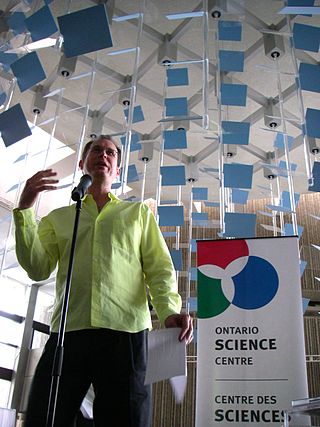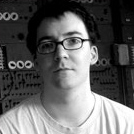
Manfred Mohr is a German artist considered to be a pioneer in the field of digital art. He has lived and worked in New York since 1981.

Rafael Lozano-Hemmer is a Mexican-Canadian electronic artist who works with ideas from architecture, technological theater and performance. Lozano-Hemmer lives and works in Montreal and Madrid.

David Rokeby is a Canadian artist who has been making works of electronic, video and installation art since 1982. He lives with his wife, acclaimed pianist Eve Egoyan, in Toronto, Canada.

Roger Luke DuBois is an American composer, performer, conceptual new media artist, programmer, record producer and pedagogue based in New York City.
Cyberarts or cyberart refers to the class of art produced with the help of computer software and hardware, often with an interactive or multimedia aspect.
Kenneth E. Rinaldo is an American neo-conceptual artist and arts educator, known for his interactive robotics, 3D animation, and BioArt installations. His works include Autopoiesis (2000), and Augmented Fish Reality (2004), a fish-driven robot.
Peter Campus, often styled as peter campus, is an American artist and a pioneer of new media and video art, known for his interactive video installations, single-channel video works, and photography. His work is held in the collections of numerous public institutions, including The Museum of Modern Art, Whitney Museum of American Art, Solomon R. Guggenheim Museum, Hamburger Bahnhof - Museum für Gegenwart, Tate Modern, Museo Reina Sofía, Albright-Knox Art Gallery, Walker Art Center, and the Centre Georges Pompidou. The artist works on the south shore of Long Island.
Camille Utterback is an interactive installation artist. Initially trained as a painter, her work is at the intersection of painting and interactive art. One of her most well-known installations is the work Text Rain (1999).
Michael Joaquin Grey is an American artist, inventor, and educator based in New York City.
Mark Napier is an early adopter of the web and a pioneer of digital and Internet art (net.art) in the United States, known for creating interactive online artwork that challenges traditional definitions of art. He uses code as an expressive form, and the Internet as his exhibition space and laboratory. Napier developed his first web-based applications for financial data in 1996. He is the author of his own website, potatoland.org, his online studio where many of his net artworks can be found, such as Shredder 1.0, net.flag, Riot, etc.

Casey Edwin Barker Reas, also known as C. E. B. Reas or Casey Reas, is an American artist whose conceptual, procedural and minimal artworks explore ideas through the contemporary lens of software. Reas is perhaps best known for having created, with Ben Fry, the Processing programming language.

Golan Levin is an American new media artist, composer, performer and engineer interested in developing artifacts and events which explore supple new modes of reactive expression.
Michael Rees is an American artist practicing sculpture making, installation, animation, and interactive computing. He has exhibited his works widely, including at the Whitney Museum of American Art, New York, NY ; Bitforms gallery, Universal Concepts Unlimited, The Aldrich Museum of Contemporary Art, Ridgefield, CT, The MARTa Museum, Herford, Germany, and The Kemper Museum of Contemporary Art, Kansas City, MO. He has experimented with a broad practice that includes performance, interactive computer programs, digital modeling and fabrication, animation, and video. Rees' work with digital media has been written about and illustrated in books, articles, and catalogues for exhibitions. His talk at the Rothko Chapel, Houston, Texas is also published.
Paul Sermon was born 23 March 1966, in Oxford, England. Since September 2013 he has worked as Professor of Visual Communication in the Faculty of Arts at the University of Brighton.
Sachiko Kodama is a Japanese artist. She is best known for her artwork using ferrofluid, a dark colloidal suspension of magnetic nano-particles dispersed in solution which remains strongly magnetic in its fluid. By controlling the fluid with a magnetic field, it is formed to create complex 3-dimensional shapes as a "liquid sculpture".
Zimoun is a Swiss artist who lives and works in Bern, Switzerland. As self-taught artist, he is most known for his sound sculptures, sound architectures and installation art that combine raw, industrial materials such as cardboard boxes, plastic bags, or old furniture, with mechanical elements such as dc-motors, wires, microphones, speakers and ventilators.
Nina Sobell is a contemporary sculptor, videographer, and performance artist. She began creating web-based artworks in the early 1990s.

Ars Electronica Linz GmbH is an Austrian cultural, educational and scientific institute active in the field of new media art, founded in Linz in 1979. It is based at the Ars Electronica Center (AEC), which houses the Museum of the Future, in the city of Linz. Ars Electronica's activities focus on the interlinkages between art, technology and society. It runs an annual festival, and manages a multidisciplinary media arts R&D facility known as the Futurelab. It also confers the Prix Ars Electronica awards.
Kelly Heaton is a sculptor, scientist, perfumer, and spiritualist known for her combination of visual art with analog electrical engineering. She is the owner and perfumer for The Virginia Perfume Company.
Wendy Maruyama is an American visual artist, furniture maker, and educator from California. She was born in La Junta, Colorado.








